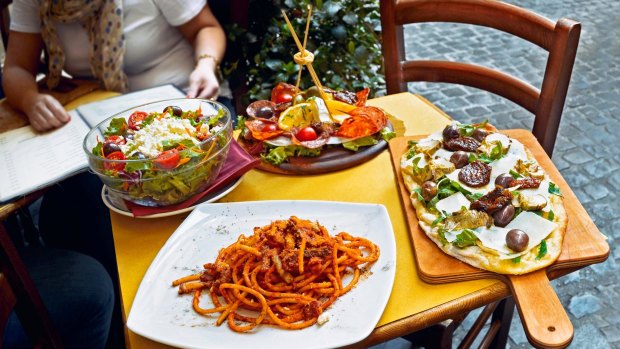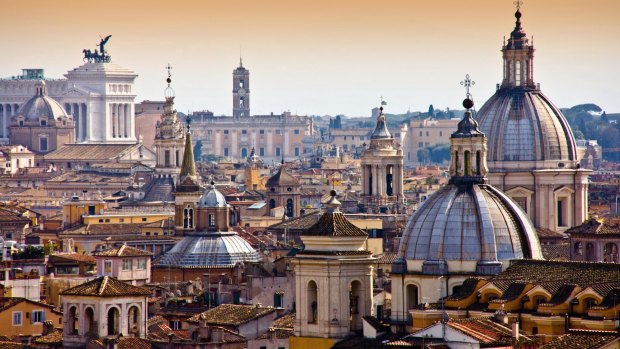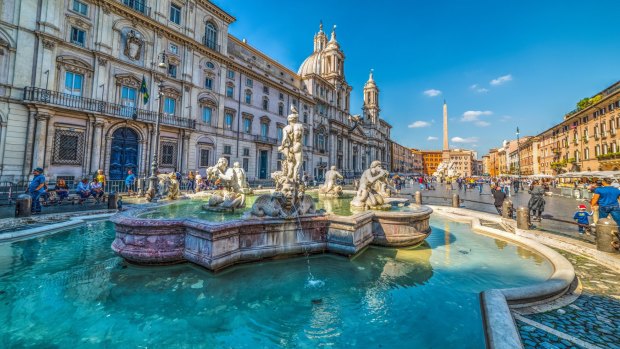By Nicholas Whitlam

A summer dinner in Rome.Credit: Shutterstock
I first went to Rome more than 50 years ago. My tour guide was my father, and he took me straight to the Roman Forum.
These days the ancient ruins of the Forum, the Palatine hill, and the Colosseum are over-run with visitors and, while this core remains a good place to start, it's best to plan your visit. A Roma Pass will do the trick, getting you into the sites without waiting in long lines. In no time you'll understand how a victorious general's "triumph" marched through the city, along the via Sacra into the Forum and up the Capitoline hill to a ritual sacrifice at the temple of Jupiter.

Whether you're there for the architecture, the history or the food, it pays to plan your visit to Rome.Credit: Shutterstock
For some, Rome is St Peter's and the Vatican. Again, there are logistical issues: St Peter's opens at 7am and, if you don't want to line up for an hour or more, that's the best time to go. Late afternoon can work too; it closes at 7pm. As to the Vatican and its museums, there is no means around the crowds and queues other than signing up for a tour.
The best views of Rome are from the "Wedding Cake", the awful and awfully large snow white building next to the Capitoline Hill; officially the Monumento Nazionale a Vittorio Emanuele II, and celebrating King Vittorio Emanuele II's role in uniting modern Italy, it houses much memorabilia of those events. (The king, his son Umberto and Queen Margherita of pizza fame, died before the monstrosity was built and are sensibly buried in the wonderful Pantheon.) There is no need to take the vertigo-inducing lift to the top level, as views from the walk up mid-level give a better perspective. An alternative is the view from the Villa Medici, the French Academy on the Pincio.
The best way to understand the layers of Rome's history is to visit the Basilica of San Clemente, near the Colosseum. The Irish Dominicans became caretakers of this church in 1667 when England disestablished the Irish Catholic church and expelled its clergy. They knew that the handsome 12th century church was built on an earlier fourth century one, but it took an enquiring Dominican leader to go down another layer – in the 1860s – to unearth the first century Roman ruins, which include a grand house and mithraeum. No real crowds, and the adjacent cloisters provide some good historical background and good WCs.

Fontana del Moro in Piazza Navona.Credit: Shutterstock
Perhaps my favourite site is the Pantheon, now technically a church, still recognisable as the pagan temple rebuilt by Emperor Hadrian and retaining the original edifice, which declares Augustus' side-kick Marcus Agrippa to be its founder. Other favourites are San Carlo alle Quattro Fontane, Borromini's exquisite little church on the Quirinale hill, Michelangelo's Santa Maria degli Angeli (built within of the Baths of Diocletian), and San Luigi dei Francesi, the French church, just off the main pedestrian walk between the Piazza Navona and the Pantheon, which has three fine Caravaggios.
One of the best art collections is housed in the Palazzo Doria Pamphilj, a heavy grey stone edifice on the Via del Corso at the Piazza Venezia end. But what a delight it is to enter the courtyard within! And then there are the glorious staterooms and galleries and a superb art collection featuring Velazquez' scarlet Pope Innocent X (Giovan Battista Pamphilj), three Caravaggios and much more. The coffee shop is a good place to have lunch.
Food is important to Romans. There are countless good choices from fancy restaurants, morning shopping in the Campo dei Fiori ("flower market"), local bistros, to shopfronts with delicious panini. My own favourite restaurants start with the La Campana, identified as "the oldest restaurant in Rome", where the antipasti are always perfect as is almost everything else including the service. Vladimiro, which was Marcello until a few years ago until head waiter Vladimiro took over; in a side street near the Via Veneto, serves the city's best veal shank ("stinco") – vitello all romana – and at reasonable prices. And Nino, down in the flash shopping district, is famous for its Florentine specialities such as bistecca alla fiorentina, fashion clientele, great ambience and professional service. At all these places I order the house wine and have never been disappointed.
A light lunch can be enjoyed at Cul de Sac, a wine bar behind the Piazza Navona, and Gusto, which specialises in salads and pizzas, housed diagonally opposite the must-see celebration of Augustus' rule, the Ara Pacis. The best gelato has traditionally been found at Giolitti but for some years the simple San Crispino has been the winner, with two outlets, one near the Trevi fountain and the other near the Pantheon. The best coffee, made with water from an ancient aqueduct, is served – sitting down outside or standing up at the bar (where you pay in advance) – at the Sant' Eustachio Il cafe, behind the Pantheon.
You really must stay centrally, which means in the triangle formed by the two roads fanning out from the Piazza del Popolo – the Corso and Via del Babuino (which runs past the Spanish Steps) – towards the Trevi Fountain and the Wedding Cake; or up on top of the Spanish Steps and around Via Veneto; or around the Pantheon and the Piazza Navona. Top of the line is the Hotel de Russie, where a bellini flute costs €23! My favourites include Margutta19 (on the artists' street that housed the Gregory Peck character in Roman Holiday, at via Margutta 51), and the historic Hotel d'Inghilterra, which has attractive public rooms and a great bar; also the Albergo del Sol, right in the middle of things at the Pantheon, and the understated Hotel Victoria, up near the Via Veneto and overlooking the Borghese Gardens.
Music of all sorts abounds, in churches, clubs and public places – notably the new auditorium near the Olympic stadium. There is good opera and ballet – and legendary acoustics – in the famous opera house: largely refurbished in Mussolini-era, it sits behind the via Nazionale and industrial strikes are happily no longer the order of the day. For the ultimate show you can once again enjoy a summer season of opera and more (e.g. Bjork, Joan Baez, Ennio Morricone and Patti Smith in 2018) under the stars at the Baths of Caracalla, where Aida is still featured as it was half a century ago – with cold beer served in the aisles and seemingly half the Rome zoo on stage: elephants, giraffes, the lot.
From Melbourne and Sydney each of Emirates/Qantas, Qatar and Etihad/Virgin have excellent and quick (one-stop) flights to and from Rome.
STAY
Hotel d'Inghilterra: Via Bocca di Leone 14; starhotelscollezione.com
Margutta19: Via Margutta 19; romeluxuryhotels.com
Hotel de Russie: Via del Babuino 9; roccofortehotels.com
Albergo del Sol: Piazza della Rotunda 63; hotelsolpantheon.com
Hotel Victoria: Via Campania 41; hotelvictoriaroma.com
EAT AND DRINK
La Campana: Vicolo della Campana 18; ristorantecampana.com
Cul de Sac: Piazza di Pasquino 73; enotecaculdesac.it
Il Gelato di San Crispino: Via della Panetteria 42 and piazza della Maddalena 3; ilgelatodisancrispino.com
Gusto: Piazza Augusto Imperatore 9; gusto.it
Ristorante Nino: Via Borgognona 11; ristorantenino.it
Ristorante Vladimiro: Via Aurora 37; ristorantevladimiro.com
Sant'Estachio Il Caffe: Piazza di San Estachio 82; santestachioilcaffe.it
CULTURE AND HISTORY
Roma Pass, see romapass.it
Teatro dell'Opera di Roma, see operaroma.it
Nicholas Whitlam's new book Four Weeks One Summer logs how in the summer of 1936, over just four weeks, it all went wrong – for democracy and for Spain, even for the British royals, how politicians failed and how Hitler, who was hosting the Berlin Olympics, was emboldened to plan a new European war, and more.
Sign up for the Traveller Deals newsletter
Get exclusive travel deals delivered straight to your inbox. Sign up now.